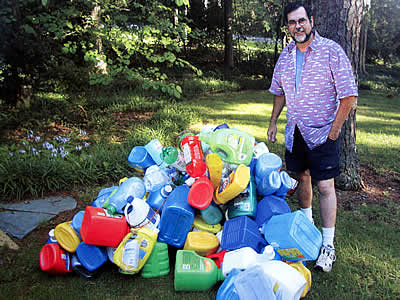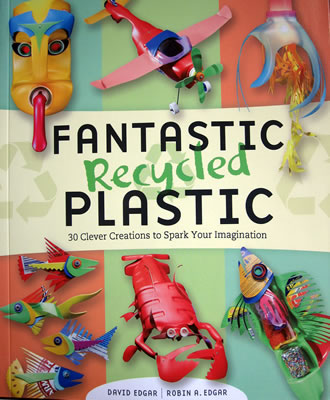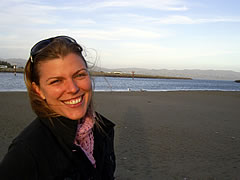Where Should Fake Plastic Fish Live?
In a Plastiquarium, of course!

Plastiquarium is the creation of artist David Edgar, whose work was pointed out to me long ago by an astute Fake Plastic Fish reader. According to legend:
The Plastiquarium is immersed in mystery. Modern myth suggests that a century of increasing phosphate levels in Earth’s marine environment caused new, synthetic life forms to emerge. As recyclable HDPE plastic containers spread concentrates of consumer product pollutants, the Plastiquarium creatures evolved in the image of their packaging forbearers.
And it’s not just fish. Other marine creatures like crustaceans have evolved into plastic versions of their former selves.

The Artist Explains
Wow, I thought. Another human has the same idea as I do, that “if we keep filling up our oceans with plastic, [fake plastic fish] could be the only kind we have left….” and has realized it beautifully it in a tangible way. It’s the theme of this blog. How could I not contact the guy and find out more about it? So that’s what I did.
David Edgar and I had a long and thought-provoking conversation about art and materials and consumerism. And he told me more about the evolution of the Plastiquarium species, explaining that pollutants in the plastic containers (mostly laundry detergent bottles) are triggering new forms of life that mimic the packaging that spreads the pollutants in the first place. Just as we carry the memory of our forefathers, they carry the memory of the products that triggered their strange mutations.
Right now, we are taking an ancient liquid — oil — which has lain beneath the surface of the earth for eons, and brought it to the surface, where we are creating a whole new layer for geologists to find millions of years into the future. What will they think of our civilization, if in fact they are even around to discover it? Will they call it the Plastizoic Era?
Source of the Materials
Back the the realm of practicality and craft, Dave explained how he collects his materials. With full support of the local recycling center, he takes walks through the neighborhood dragging behind him a 4-foot length of cord, to which he attaches all the colorful detergent bottles he finds in residents’ recycle bins.  The shapes of these HDPE (#2 plastic) bottles are what inspired him in the first place, suggesting to his artist’s mind creatures from the sea.

Back in his studio, he uses various techniques to transform the objects into the creatures he imagines. Originally, David would remove the labels from the bottles. But eventually, he realized that the labels were a further layer of comment on our consumer-oriented society.
Part of David’s technique is melting the plastic to create new forms. He is concerned about chemicals that can be released, so he works in a well-ventilated area and is very careful not to allow the plastic to burn. He says the worst part of the work, actually, is breathing the synthetic fragrances from the leftover product. He has to work with some diligence to get the smell out — the smell, by the way, that a Procter & Gamble rep told me consumers want even more of. Personally, the more I get that stuff out of my life, the more sensitive I am to it, so I can appreciate what David goes through to realize his creations. And perhaps the discomfort and exposure to the toxicity of his materials is part of his own process. He didn’t say that, but I wonder…
Fantastic Recycled Plastic
David and his wife Robin have put together a beautiful art/craft book, titled Fantastic Recycled Plastic: 30 Clever Creations to Spark Your Imagination, based on not only the Plastiquarium but other plastic creations like birds, insects, and flowers, as well as the work of other artists in the recycled plastic medium. What’s more, the beginning sections of the book explain the history of plastic as well as problems with plastic recycling and environmental issues.  In fact, there is a whole page about the Great Pacific Garbage Patch.

Other sections of the book explain materials and tools used to create the art and give instructions for some of the techniques themselves. The book would be a great resource for teachers, I think, providing information about the issues of plastic as well as ideas for art projects.












Great feature. My daughter isn’t really old enough yet to understand recycling or issues surrounding plastics, though, like many urban toddlers, she loves to pick up trash and throw it away. The ideas in the book might make for great gifts for my nephew and nieces though, and we’ll have to resort to the same technique of raiding the neighbors recycling bins.
The book looks great. I’ve been a recycler for years and have now moved to reducer and come to your blog for inspiration – which I always find in abundance – thanks. I often participate in science fairs and this would be a great resource for the kids.
I work as a child advocate at a domestic violence shelter, and every summer we do a unit on “going green” that includes touring the local landfills and recycling center, education and fun activities to get the kids excited about activism. I am of the opinion that empowering kids to try to change their world is particularly important for children who may have spent their entire lives thinking that they can do nothing to change their circumstances…
Anyway, I’d love to use this book for our activities this year! Our local library does not have a copy, it would be great to be able to use the book and then donate it so others in my community can do the same.
Either way, thanks for all you do, Beth!
I think this is pretty and fun but I also feel a bit critical. Artists are often using recycled materials in their work. The materials he is using are already in recycle bins (which I know is downcycling) but it seems like the upcycling (into art) would be more productive if he found the materials in the trash or as litter. I feel bad for this artists health as he is melting the plastic and dealing with the perfumes in high concentrations. Sadly artists do this a lot with paint fumes and such)
If you are going to make items for your home (especially outside) make sure animals won’t get trapped in them!!!
What beautiful art made of such a crummy material. Thank you for sharing this work! And PLEASE enter me in the giveaway — I don’t think there is any better way of teaching my students (grades k-3) about plastic waste than by making toys out of trash.
I would find this book useful for working with my kids (4 and almost 2) to learn about plastic. I haven’t yet found a good way to teach about plastic specifically, but we do talk about (well, I talk) about waste in general. I talk about how we use the minimum of resources, that resources are limited, that it is better to reuse.
When I worked in Japan as a teacher, I tried to discuss the plastic usage issue with my students as much as possible. Japanese people have a tradition of over packing everything and I often asked the kids about the different ways they could reuse many of the plastic containers and wrappers.
Oh, I must have this book! I always think about making something out of plastic trash bfore I recycle it.
That is why I came up with my idea of “Dancing with Plastic Trash Costumes”.
It really works and many local environmental organizations love it! In fact, we are dancng for two Earth Day events in Los Angeles this month.
Approaching kids and parents with a fun surprise while giving our messages is effective. – Danc 4 Oceans
I have a little story about my step-son and toys in cereal.
One day, we were grocery shopping together. He is looking at all the cereal boxes and their giveaways (plastic of course). He finally finds the perfect giveaway that he wants and asks if we can buy the cereal. I told him I would be more than happy to purchase the cereal for him but he wouldn’t be getting his favourite cereal until he finished this box of cereal. He put it back on the shelf.
I tried to explain to him that the cereal makers use the toys to trick him into buying cereal he wouldn’t normally buy. I don’t think he understood what I was trying to say but he has never brought cereal into the house for its toy again.
And yes, I know that cereal wrapping has plastic in it but only one of us cares about plastic and the other parent demands their right to purchase whatever plastic they want. I only control the plastic that I consume since I can really only control me.
I think the book is very interesting and I would love to win it.
Ok–I usually tell people not to count me in giveaways because I live in France, but if I win this one, I’ll pay the postage. My husband is a primary school teacher and is always looking for art projects for kids–and the book sounds great because it re-uses plastic and teaches about it at the same time.
So count me in.
So this reminded me of this guy who lives near me who also repurposes materials for his art. He mainly repurposes old garage doors but he also had these hanging from his trees outside his house. So here is your official ‘fake plastic fish’.
https://s.yimg.com/pw/images/en-us/photo_unavailable.png
Yikes! This post makes me realize I SHOULD be doing something besides recycling my plastic containers (which is really downcycling, I know!). At first I thought, “Oh, how pretty.” Then I realized the source of the materials and I’m awed (at the artist talent), sickened (by the availabilty of the medium) and humbled (at my lack of effort in getting the message out). Thanks for the kick in the pants.
It’s so amazing some of the stuff he comes up with! recycling plastic “rubbish” into art pieces I’d happily display on my wall!!
oh, the book is beautiful!
We do a lot of scavenging the neighborhood for plastic materials – bottles to fill with shampoo, nonrecyclable yogurt containers to start seeds in, etc. My 4 year old asks to take trash walks – it’s like a scavenger hunt for him, and sometimes he finds a plastic toy he loves that I would never in a million years have bought for him.
This book is right up my alley! You know I am a big re-user, but will probably buy this book so don’t enter me. Maybe I will make you a fake plastic fish!
Every year we team up with Surfrider Foundation and Big Brothers Big Sisters to teach city kids how to surf. We always include time to teach the kids about water pollution. Last year we took them on a quick cleanup of the beach, gave each of them an item from our find (glass, plastic, can, etc) and asked them to put themselves in order of how long it would take the item they were holding to degrade.
Sometimes we show the Inky the Whale video.
Plastic bottle tops have taken over cigarette butts as the number one item found on our beaches.